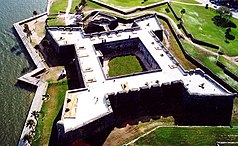Castillo de San Marcos National Monument
| Castillo de San Marcos National Monument | ||
|---|---|---|
| Castillo de San Marcos | ||
|
|
||
| Location: | United States | |
| Next city: | St. Augustine | |
| Surface: | 0.1 km² | |
| Founding: | October 15, 1924 | |
| Visitors: | 600,252 (2005) | |
The Castillo de San Marcos is a fort in St. Augustine , Florida, built by the Spanish . It was named Fort St. Mark under British occupation from 1763 to 1784, and Fort Marion from 1821 to 1842 under American leadership .
history
The city of St. Augustine was founded in 1565. For the first 100 years of its existence, the city was defended by nine wooden forts. After an attack in 1668, the Spanish royal family decided to build stronger fortifications to protect the city. In October 1672, construction work on what is now Castillo began.
Havana workers built the fort over a period of 23 years. As early as 1702, the British, under the command of Governor James Moore, besieged the fort, starting from the city of Charleston in South Carolina , founded in 1670 , which was only two sea days away. During the two-month siege, 1200 residents of the city lived together with 300 soldiers stationed there in the fort. Starting from Havana, a Spanish fleet was able to break the siege. The British had to sink their ships to keep them from falling into Spanish hands. When they left, they set the city of St. Augustine on fire, which burned to the ground, and fled overland to what was then the British colony of Carolina.
In 1738, under the direction of Basque engineer Pedro Ruiz de Olano, the fort was rebuilt, the walls reinforced and the wooden ceilings replaced with stone vaulted ceilings to increase the load-bearing capacity for heavier cannons.
In 1739 tensions between Great Britain and Spain led to a colonial war . As a result of this war, the British under the leadership of General James Oglethorpe besieged the fort and the city again. The Spanish governor Manuel de Montiano directed the defense of the city. Oglethorpe came from the new British colony of Georgia and conquered Fort San Diego, Fort Picolotta, and Fort Mose until he finally besieged St. Augustine. He kept firing on the city and fort, blocking important supply routes at sea in the hope that the governor would quickly give up. However, the Spaniards occasionally managed to break through the blockades and ultimately the fort withstood the heavy bombardment. After 38 days, the British withdrew without having achieved anything.
In 1763 the fort passed into British ownership when Spain ceded Florida to the British through the Peace of Paris and in return received Havana and Manila. The fort's name was changed to Fort St. Mark .
At the beginning of the American independence movement, the British declared St. Augustine the capital of East Florida and repaired the previously neglected fort. The fort became an important base for all military operations in southern North America, but only played a minor role in the War of Independence itself. In 1779 Spain declared war on Great Britain, at the end of which Florida returned to Spain through the Peace of Paris in 1783 . In 1784 Spanish soldiers returned to the Castillo.
Much had changed when the Spanish took possession of the fort again. Many Spaniards had left the country when Florida passed into British possession, who remained now resident residents. Border problems with the developing United States were commonplace. The fort got its original name back and was reinforced to consolidate Spain's presence in the region. Ultimately, however, Spain ceded Florida to the United States in 1821.
Florida separated from the United States in 1861, and the Union forces withdrew all but one man. A short time later the Confederates took over the fort. All weapons were moved to other facilities and the fort itself was defenseless.
In 1862 the fort was retaken by the Union when they sailed into the bay with the USS Wabash and found the fort and town defenseless. The fort was then converted into a prison . Many Indians were arrested, but also deserters.
From 1875 72 Indian leaders were brought into the fort in chains. Under the direction of Major Richard Pratt, they were to be reeducated into civilized citizens; true to his battle cry: "Kill the Indian and save the people". The treatment was martial, but the uniformed prisoners were also encouraged to draw freely, thus promoting the establishment of the first Indian art school. Important representatives of this newer Indian graphic ( Ledger Art ) were: Paul Caryl Zotom (Kiowa), David Pendleton Oakerhater (Okuhhatuh or Making Medicine, Cheyenne), Tichtematse or Squint Eyes (Cheyenne), Wohaw (Kiowa), Howling Wolf (Cheyenne), Etahdleuh Doanmoe (Kiowa), White Bear (Arapaho), Koba (Kiowa) and Bear's Heart (Cheyenne).
From 1900 the fort had no function and was converted into a national monument in 1924. In 1933 the fort was placed under the National Park Service , which again changed the name to the original in 1942. In 1966 it was entered on the National Register of Historic Places . The fort is administered as a unit with Fort Matanzas National Monument .
See also
swell
- 2006 Statistical Abstract, Public Use Statistics Office, National Park Service
- National Park Service, Listing of Acreages by Park 12/31/03
Web links
- National Park Service: Castillo de San Marcos National Monument (official site; English)
Individual evidence
- ^ Christian F. Feest , Cultures of the North American Indians, Bonn, 2000, page 25


